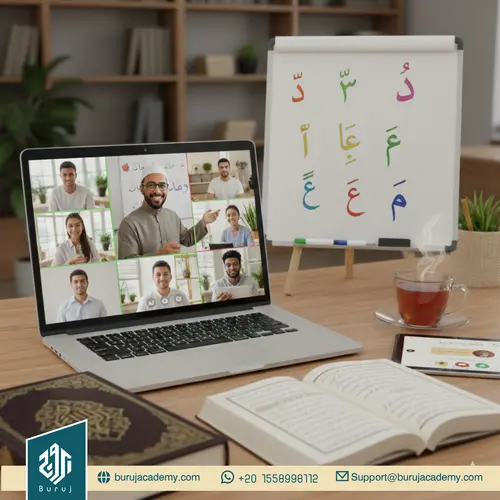Quran Recitation with Correct Pronunciation : A Guide to Mastery
In Islam, Quran recitation with correct pronunciation is a profound act of worship, a direct communion with the divine. It is an act that demands not just heartfelt sincerity, but also linguistic precision. The difference between a sincere but grammatically flawed recitation and one that adheres to the rules is monumental, potentially altering the very meaning of the sacred words. This precision is achieved through the science of Tajweed (تجويد), an Arabic term meaning “to make better” or “to improve.”
Contact Us For More Details
This article is your complete guide to understanding, learning, and mastering the art of Quran recitation with correct pronunciation. We will explore the core rules of Tajweed, highlight the most common mistakes to avoid, and provide actionable, proven strategies to transform your reading from hesitant to beautiful, connecting you more deeply with the eternal message of Allah.
The Importance of quran recitation with correct pronunciation
The Quran, written in classical Arabic, requires precise pronunciation known as the science of Tajweed. It governs the rules by which each Arabic letter is articulated with specific qualities like length, vocalization, and emphasis. Reciting without Tajweed may alter meanings, affecting the devotional experience.
Quran recitation with correct pronunciation:
- Ensures the divine message remains intact
- Enhances the listener’s spiritual experience
- Honors the tradition of the Prophet and early Muslim masters
- Builds confidence for personal and communal recitation
The Core Pillars of quran recitation with correct pronunciation:
The entire science of quran recitation with correct pronunciation rests on mastering two foundational concepts:
Makharij al-Huroof (Articulation Points)
This refers to the precise point of origin of each of the 29 Arabic letters in the mouth, throat, or nose. Misplacing the articulation point for even one letter can lead to a drastic change in the word’s meaning.
Example: The difference between the sounds of Haa from the middle of the throat and Haa from the bottom of the throat. Confusing them in certain verses can change the word entirely.
Sifaat al-Huroof (Characteristics of Letters)
These are the qualities that accompany a letter, such as heaviness (Tafkheem) or lightness (Tarqeeq), breathiness (Hams), or vibration (Qalqalah).
- Example: Making the letter heavy in some contexts (like when it has a Fatha or Damma) and light in others (like when it has a Kasra).
Key Quran recitation with correct Rules for Beginners
For non-native Arabic speakers and beginners, the full set of Tajweed rules can be overwhelming. Focusing on these fundamental rules first will provide the most significant improvement to your recitation.
- Rules of Noon Saakinah and Tanween (The ‘N’ Sound)
This is one of the most comprehensive areas of Tajweed, governing how the letter (ن) or the double vowel signs are pronounced when they are not followed by a vowel. They fall into four main categories:
- Izhaar (Clear Pronunciation): Pronouncing the sound clearly, often when followed by a throat letter.
- Idghaam (Merging): Merging the sound into the following letter, sometimes with a nasal sound (Ghunnah) and sometimes without.
- Ikhfaa (Concealment/Hiding): Hiding the sound, almost concealing it, and applying a Ghunnah (nasal sound).
- Iqlaab (Conversion): Converting the sound into a () sound when followed by the letter ().
- Madd (Elongation Rules)
Madd refers to the lengthening of a vowel sound. Correctly applying Madd is crucial for maintaining the rhythm (Tarteel) of the recitation and is necessary for many words.
- Natural Madd (Madd Asli): The basic two-count stretch of the vowel sound.
- Secondary Madd (Madd Far’i): Longer stretches (four or six counts) required when a long vowel is followed by a or a .
- Qalqalah (Echoing Sound)
This rule applies to five specific consonants (, , , , ) when they have a sukoon (vowelless). The letter’s articulation point must be quickly released, creating a light, echoing, or bouncing sound.
Top 5 Common Mistakes in Recitation (Lahn)
Mistakes in recitation are categorized into two types: Lahn Jali (major, meaning-altering errors) and Lahn Khafi (minor, beauty-reducing errors). Avoiding the following Lahn Jali mistakes is paramount:
- Mispronouncing Makharij (Altering the Word’s Meaning)
This is the single most critical error. It happens when reciters confuse similar-sounding letters (e.g., vs. , vs. , vs. ).
- Solution: Dedicated practice on the Makharij charts and repeating the letter in its different vowel forms (Fatha, Kasra, Damma).
- Ignoring Madd Lengths (Over- or Under-stretching)
Shortening a required long Madd (like a 4 or 6-count Madd) or lengthening a short vowel is a common mistake that disrupts the rhythm of the verse and can be Lahn Jali.
- Solution: Use your fingers to count the beats/vowel-counts during practice until the timing becomes natural.
- Improper Use of Ghunnah (Nasal Sound)
Either skipping the nasal sound when it’s required (e.g., in and with a Shaddah) or applying it unnecessarily (e.g., on a Noon Saakinah with Izhaar).
- Solution: Listen to the experts and focus specifically on the duration generally held for the length of two short vowels (two counts).
- Incorrect Stopping and Pausing (Waqf and Ibtida)
Stopping at a point that breaks the sentence’s meaning (e.g., stopping between a verb and its subject) can change the meaning dramatically. Similarly, restarting the recitation from an inappropriate word is problematic.
- Solution: Learn the standardized symbols (like for necessary stop, for do not stop) found in most printed Qurans.
- Neglecting Tafkheem and Tarqeeq (Heavy and Light Letters)
Failing to make a heavy letter like or heavy, or making a light letter like or heavy, can lead to mispronunciation.
- Solution: Memorize the heavy letters (, , , , , , ) and the rules for when the letter is heavy or light.
Practical Steps to Mastering Recitation
Learning Tajweed is a journey that requires patience, consistency, and the right approach. Technology has made it easier than ever for seekers worldwide.
- Find a Qualified Teacher (The Traditional Path)
The most effective method is learning from a teacher who has an Ijazah (a certified chain of transmission back to the Prophet ). A teacher can hear your mistakes instantly, correct your Makharij (articulation points) in real-time, and prevent you from developing bad habits. Online Tajweed classes and personalized virtual tutoring have made this accessible globally Check out Buruj Academy’s Tajweed courses today!
- Start with the Basics: Al-Qaida al-Noorania
Before tackling the Quran directly, beginners should use a foundational textbook like the Al-Qaida al-Noorania. This resource systematically teaches the Arabic alphabet, short and long vowels, , , and the fundamental rules of and in a structured way.
- Listen and Imitate (The Auditory Method)
Regularly listen to renowned and authoritative reciters (Qaris) such as Sheikh Al-Husary, Sheikh Al-Sudais, or Sheikh Al-Minshawi, who known for their clear and consistent application of Tajweed.
- Actionable Tip: Listen to a verse, pause the audio, and then mimic their recitation exactly, paying close attention to the length of the and the clarity of the .
- Practice Consistently and Record Yourself
The Prophet Muhammad encouraged consistent deeds, even if small. Dedicate a short, consistent time—even 15 to 20 minutes daily—to practice.
- Actionable Tip: Record your own recitation and compare it side-by-side with an expert Qari’s. This is the fastest way to detect the errors your ears miss while you’re actively reciting.
- Understand the Meaning (Tafsir)
When you understand the meaning (Tafsir) of the verses, your heart and mind connect with the words. This connection naturally influences your intonation, breathing, and stopping points, helping you recite with appropriate emotional depth and clarity.
Benefits of Learning Correct Quran Recitation
- Spiritual upliftment and connection with Allah
- Increased memorization effectiveness
- Confidence in public and congregational recitation
- Deeper understanding of the Quran’s linguistic intricacies
The Double Reward of Effort
The journey of mastering Quran recitation with correct pronunciation is a spiritual endeavor. The Prophet Muhammad said: “The one who is proficient in the recitation of the Qur’an will be with the noble and dutiful scribes (angels). And the one who recites the Qur’an with difficulty and stutters while reciting, will have a double reward.”
This hadith serves as a beautiful encouragement: your effort is not only rewarded with beautiful, accurate recitation but is also doubly rewarded if you struggle but persevere. By focusing on Tajweed, mastering the Makharij, and practicing consistently—ideally under the guidance of a qualified online or in-person teacher—you transform a linguistic challenge into a deeply rewarding spiritual journey. Start today by mastering the basics, and watch as your connection to the Holy Quran deepens with every perfectly pronounced letter.
Connect with Our Community
High-value education extends beyond the classroom. We provide free resources and a supportive community to help you on your journey. For free tips, student stories, and academy updates, follow us on Facebook, watch our educational lessons on YouTube, and join the conversation on Instagram.





